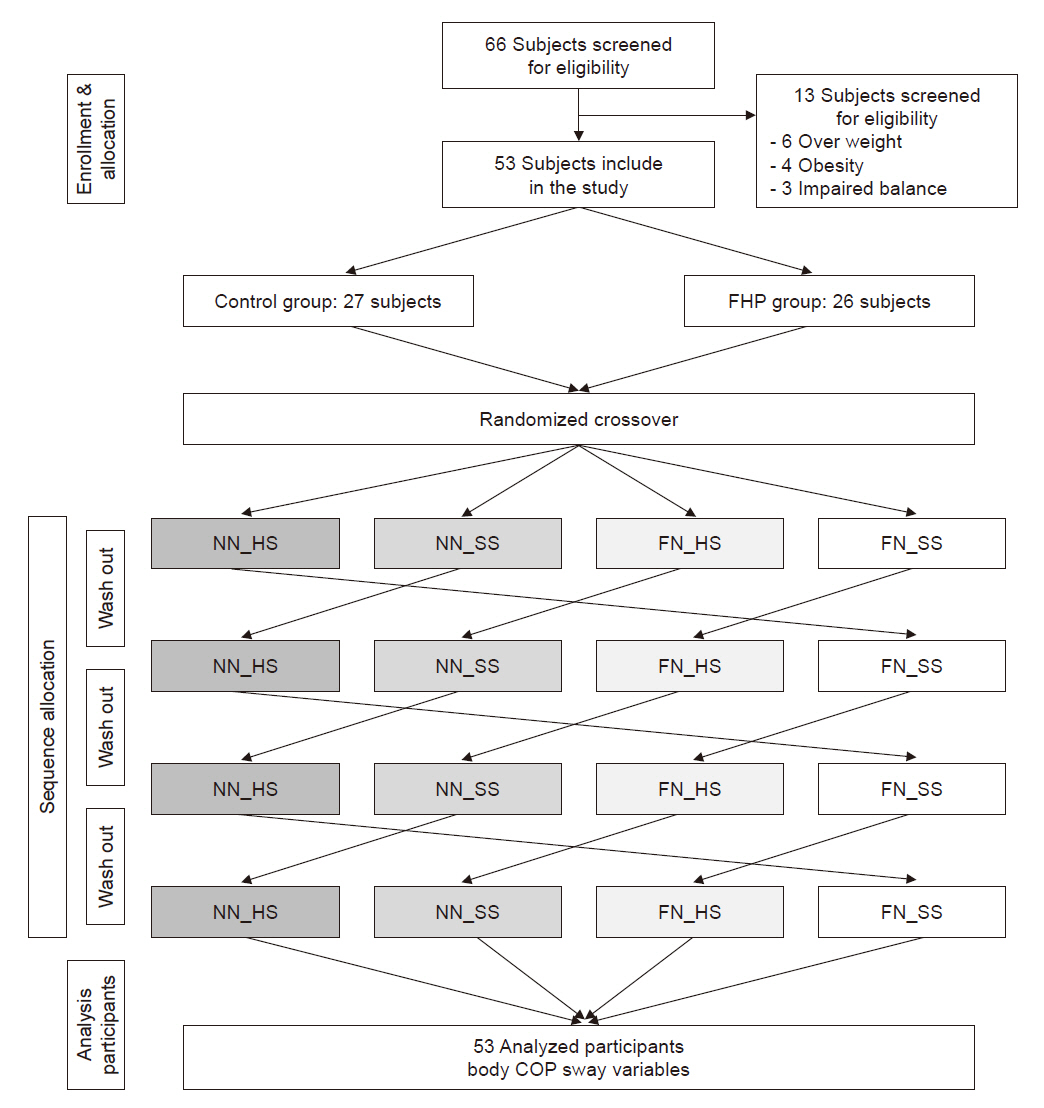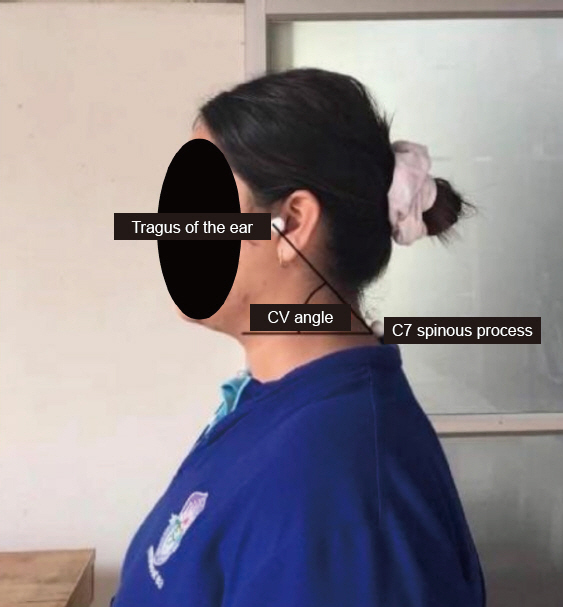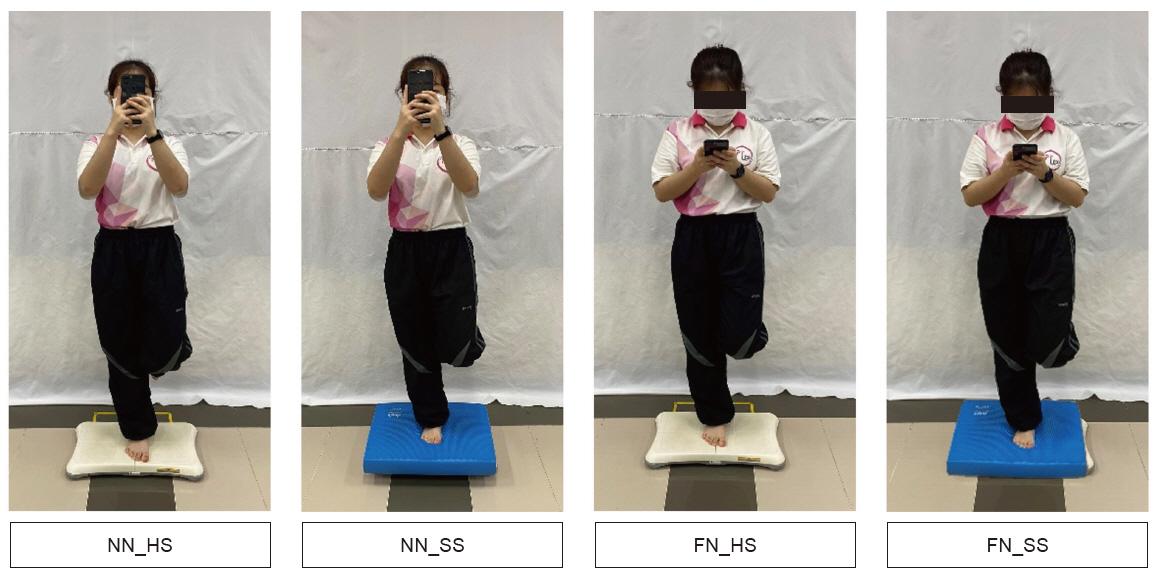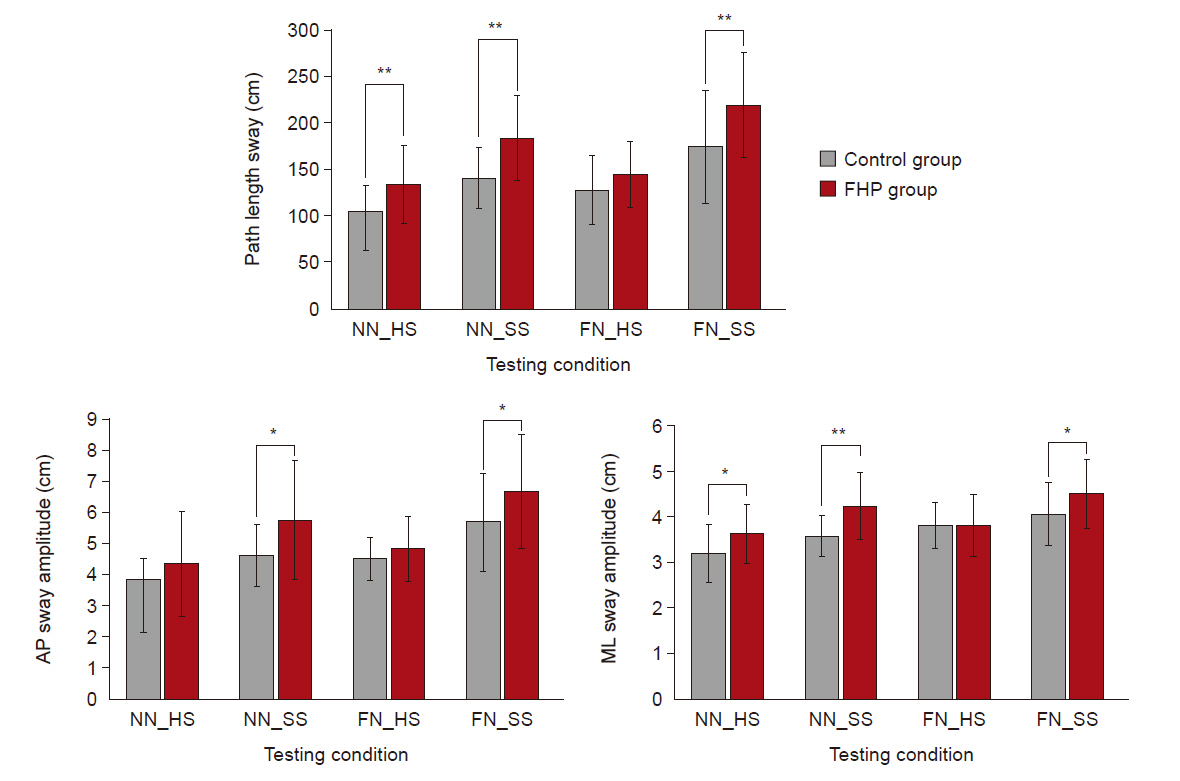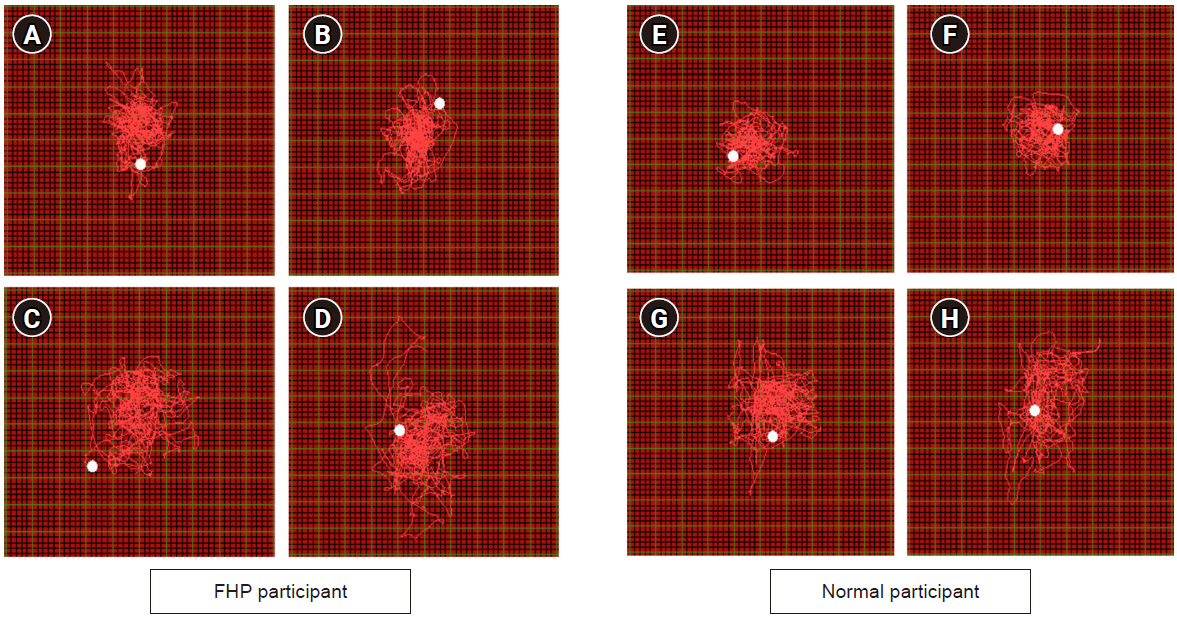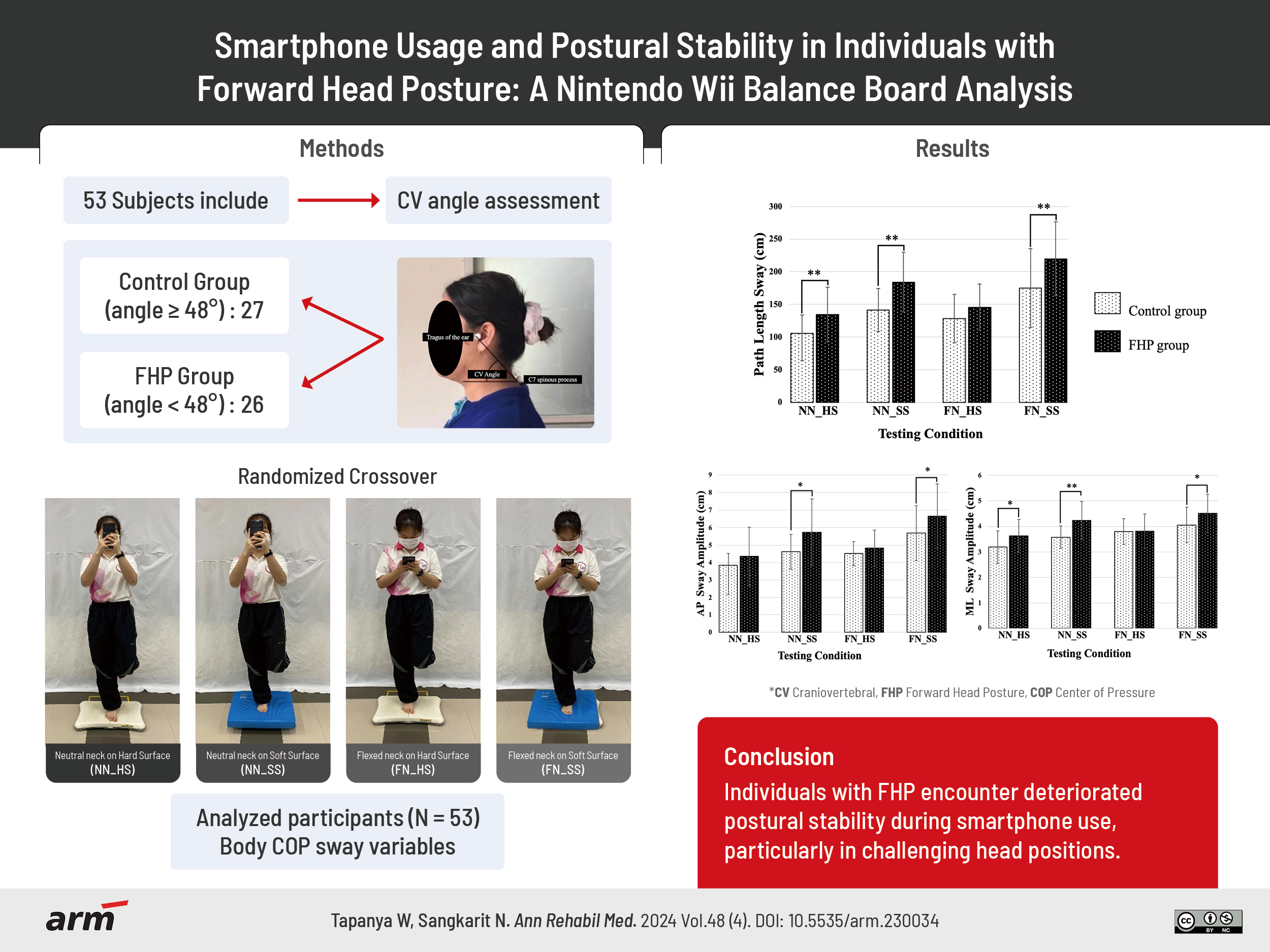Ann Rehabil Med.
2024 Aug;48(4):289-300. 10.5535/arm.230034.
Smartphone Usage and Postural Stability in Individuals With Forward Head Posture: A Nintendo Wii Balance Board Analysis
- Affiliations
-
- 1Department of Physical Therapy, School of Allied Health Sciences, University of Phayao, Phayao, Thailand
- KMID: 2558735
- DOI: http://doi.org/10.5535/arm.230034
Abstract
Objective
To assess postural stability, specifically center of body sway during single-leg standing balance, among individuals with and without forward head posture (FHP) during smartphone use.
Methods
The research recruited 53 healthy smartphone users, aged 18–25, and categorized them into FHP group comprising 26 subjects and the normal (control) group with 27 subjects. Participants were assigned the task of maintaining balance while engaged in smartphone typing during single-leg standing. The experiment involved four specific conditions according to neck posture and stable of surface. The study meticulously quantified body center of pressure (COP) sway amplitudes using the Nintendo Wii Balance Board.
Results
The research revealed that individuals with FHP exhibited significantly greater body sway compared to the control group when using smartphones. Notably, distinct variations were observed in path length sway, anteroposterior (AP), and mediolateral (ML) sway amplitude, particularly evident when maintaining flexed neck positions on a soft surface while engaged with smartphones.
Conclusion
These findings strongly suggest that individuals with FHP encounter deteriorated postural stability during smartphone use, particularly in challenging head positions.
Figure
Reference
-
1. Eitivipart AC, Viriyarojanakul S, Redhead L. Musculoskeletal disorder and pain associated with smartphone use: a systematic review of biomechanical evidence. Hong Kong Physiother J. 2018; 38:77–90.
Article2. David D, Giannini C, Chiarelli F, Mohn A. Text neck syndrome in children and adolescents. Int J Environ Res Public Health. 2021; 18:1565.
Article3. Straker L, Jones KJ, Miller J. A comparison of the postures assumed when using laptop computers and desktop computers. Appl Ergon. 1997; 28:263–8.
Article4. Torkamani MH, Mokhtarinia HR, Vahedi M, Gabel CP. Relationships between cervical sagittal posture, muscle endurance, joint position sense, range of motion and level of smartphone addiction. BMC Musculoskelet Disord. 2023; 24:61.
Article5. Hansraj KK. Assessment of stresses in the cervical spine caused by posture and position of the head. Surg Technol Int. 2014; 25:277–9.6. Norasi H, Tetteh E, Sarker P, Mirka GA, Hallbeck MS. Exploring the relationship between neck flexion and neck problems in occupational populations: a systematic review of the literature. Ergonomics. 2022; 65:587–603.
Article7. Ha SY, Sung YH. A temporary forward head posture decreases function of cervical proprioception. J Exerc Rehabil. 2020; 16:168–74.
Article8. Kasem SA, Abdel Raoof N, Kattabie O, Moustafa I. Effect of forward head posture on sensorimotor integration. Int J Physiother. 2017; 4:118–25.9. Steinberg N, Elias G, Zeev A, Witchalls J, Waddington G. The function of the proprioceptive, vestibular and visual systems following fatigue in individuals with and without chronic ankle instability. Percept Mot Skills. 2023; 130:239–59.
Article10. Malmström EM, Fransson PA, Jaxmar Bruinen T, Facic S, Tjernström F. Disturbed cervical proprioception affects perception of spatial orientation while in motion. Exp Brain Res. 2017; 235:2755–66.
Article11. Peng B, Yang L, Li Y, Liu T, Liu Y. Cervical proprioception impairment in neck pain-pathophysiology, clinical evaluation, and management: a narrative review. Pain Ther. 2021; 10:143–64.
Article12. Reddy RS, Tedla JS, Dixit S, Raizah A, Al-Otaibi ML, Gular K, et al. Cervical joint position sense and its correlations with postural stability in subjects with fibromyalgia syndrome. Life (Basel). 2022; 12:1817.
Article13. Hillier S, Immink M, Thewlis D. Assessing proprioception: a systematic review of possibilities. Neurorehabil Neural Repair. 2015; 29:933–49.14. Treleaven J. Sensorimotor disturbances in neck disorders affecting postural stability, head and eye movement control. Man Ther. 2008; 13:2–11.
Article15. Abdelkader NA, Mahmoud AY, Fayaz NA, Saad El-Din Mahmoud L. Decreased neck proprioception and postural stability after induced cervical flexor muscles fatigue. J Musculoskelet Neuronal Interact. 2020; 20:421–8.16. Kang JH, Park RY, Lee SJ, Kim JY, Yoon SR, Jung KI. The effect of the forward head posture on postural balance in long time computer based worker. Ann Rehabil Med. 2012; 36:98–104.
Article17. Kars HJ, Hijmans JM, Geertzen JH, Zijlstra W. The effect of reduced somatosensation on standing balance: a systematic review. J Diabetes Sci Technol. 2009; 3:931–43.
Article18. Lin G, Zhao X, Wang W, Wilkinson T. The relationship between forward head posture, postural control and gait: a systematic review. Gait Posture. 2022; 98:316–29.
Article19. Salahzadeh Z, Maroufi N, Ahmadi A, Behtash H, Razmjoo A, Gohari M, Parnianpour M. Assessment of forward head posture in females: observational and photogrammetry methods. J Back Musculoskelet Rehabil. 2014; 27:131–9.
Article20. Abbasi H, Alizadeh MH, Rajabi R, Mohammadi F. Comparison of static and dynamic postural stability between individuals with and without forward head posture. Phys Treat. 2020; 10:127–34.
Article21. Tapanya W, Maharan S, Amput P, Sangkarit N, Suwannakul B. The influence of knee extensor and ankle plantar flexor strength on single-leg standing balance in older women. J Funct Morphol Kinesiol. 2023; 8:67.
Article22. Fernández-de-las-Peñas C, Alonso-Blanco C, Cuadrado ML, Pareja JA. Forward head posture and neck mobility in chronic tension-type headache: a blinded, controlled study. Cephalalgia. 2006; 26:314–9.23. Gadotti IC, Magee DJ. Validity of surface measurements to assesscraniocervical posture in the sagittal plane: acritical review. Phys Ther Rev. 2008; 13:258–68.24. Gallego-Izquierdo T, Arroba-Díaz E, García-Ascoz G, Val-Cano MDA, Pecos-Martin D, Cano-de-la-Cuerda R. Psychometric proprieties of a mobile application to measure the craniovertebral angle a validation and reliability study. Int J Environ Res Public Health. 2020; 17:6521.
Article25. Xie Y, Szeto GP, Dai J, Madeleine P. A comparison of muscle activity in using touchscreen smartphone among young people with and without chronic neck-shoulder pain. Ergonomics. 2016; 59:61–72.
Article26. Haworth J, Stergiou N. Orderliness of visual stimulus motion mediates sensorimotor coordination. Front Physiol. 2018; 9:1441.
Article27. Meade ZS, Marmelat V, Mukherjee M, Sado T, Takahashi KZ. Comparison of a portable balance board for measures of persistence in postural sway. J Biomech. 2020; 100:109600.
Article28. Donath L, Roth R, Zahner L, Faude O. Testing single and double limb standing balance performance: comparison of COP path length evaluation between two devices. Gait Posture. 2012; 36:439–43.
Article29. Onofrei RR, Amaricai E, Suciu O, David VL, Rata AL, Hogea E. Smartphone use and postural balance in healthy young adults. Int J Environ Res Public Health. 2020; 17:3307.
Article30. Alshahrani A, Aly SM, Abdrabo MS, Asiri FY. Impact of smartphone usage on cervical proprioception and balance in healthy adults. Biomed Res. 2018; 29:2547–52.
Article31. McPartland JM, Brodeur RR, Hallgren RC. Chronic neck pain, standing balance, and suboccipital muscle atrophy--a pilot study. J Manipulative Physiol Ther. 1997; 20:24–9.32. Fercho J, Krakowiak M, Yuser R, Szmuda T, Zieliński P, Szarek D, et al. Kinematic analysis of the forward head posture associated with smartphone use. Symmetry. 2023; 15:667.
Article33. Lee MY, Lee HY, Yong MS. Characteristics of cervical position sense in subjects with forward head posture. J Phys Ther Sci. 2014; 26:1741–3.
Article34. Samaan MN, Elnegmy EH, Elnahhas AM, Hendawy AS. Effect of prolonged smartphone use on cervical spine and hand grip strength in adolescence. Int J Multidiscip Res Dev. 2018; 5:49–53.35. Koseki T, Kakizaki F, Hayashi S, Nishida N, Itoh M. Effect of forward head posture on thoracic shape and respiratory function. J Phys Ther Sci. 2019; 31:63–8.
Article36. Quek J, Pua YH, Clark RA, Bryant AL. Effects of thoracic kyphosis and forward head posture on cervical range of motion in older adults. Man Ther. 2013; 18:65–71.
Article37. Jouira G, Alexe CI, Herlo JN, Moraru CE, Bogdan M, Alexe DI, et al. Effects of smartphone activities on postural balance in adolescents with intellectual disabilities. Children (Basel). 2023; 10:1810.
Article38. Shiravi Z, Talebian Moghadam S, Hadian MR, Olyaei G. Effect of cognitive task on postural control of the patients with chronic ankle instability during single and double leg standing. J Bodyw Mov Ther. 2017; 21:58–62.
Article39. Lino TB, Scarmagnan GS, Sobrinho-Junior SA, Tessari GMF, Gonçalves GH, Pereira HM, et al. Impact of using smartphone while walking or standing: a study focused on age and cognition. Brain Sci. 2023; 13:987.
Article40. Wah SW, Chatchawan U, Chatprem T, Puntumetakul R. Prevalence of static balance impairment and associated factors of university student smartphone users with subclinical neck pain: cross-sectional study. Int J Environ Res Public Health. 2022; 19:10723.
Article
- Full Text Links
- Actions
-
Cited
- CITED
-
- Close
- Share
- Similar articles
-
- The Effect of Postural Correction and Visual Feedback on Muscle Activity and Head Position Change During Overhead Arm Lift Test in Subjects with Forward Head Posture
- The Effect of The Forward Head Posture on Postural Balance in Long Time Computer Based Worker
- Nintendo Wii Fit-Based Sleepiness Testing is Not Impaired by Contagious Sleepiness
- A Comparison of Dizziness Handicap Inventory Scores with Stability Index and Fourier Harmony Index in Healthy Individuals
- Effect of Self-Postural Control with Visual Feedback in the Foot Pressures in the Subject with Forward Head Posture

